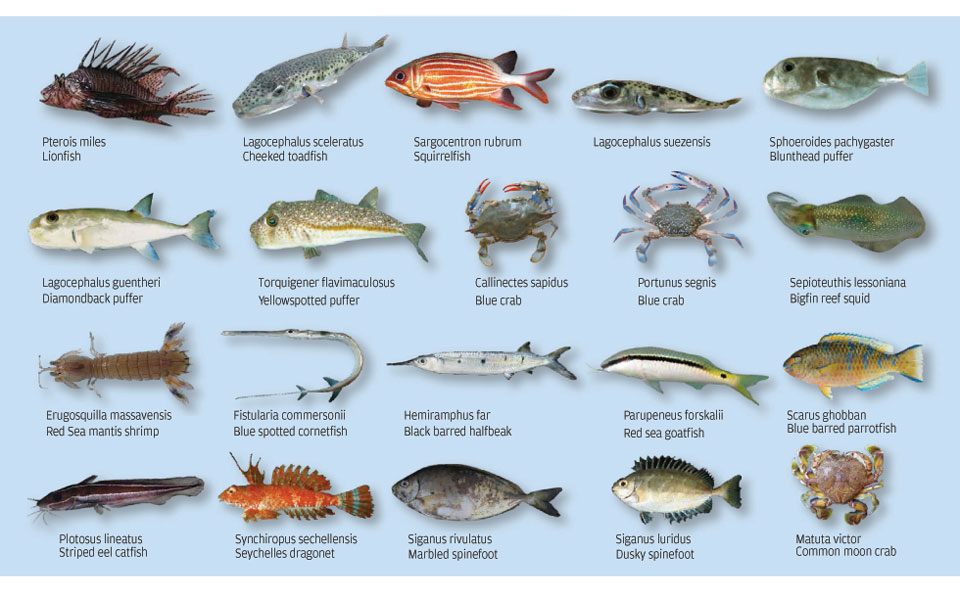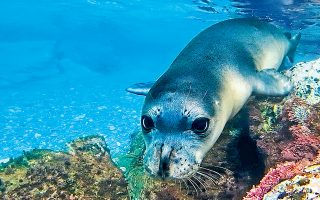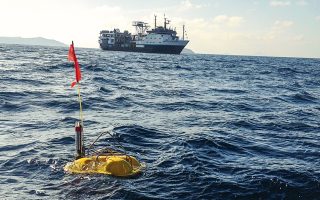Invaders threaten local marine ecosystems

Two men were rushed to hospital on Crete recently, after being stung by a beautiful yet dangerous invader. The lionfish has spiky fin rays that deliver a powerful venom which causes intense pain and swelling, and can, in some cases, lead to anaphylactic shock. Despite all of these frightening traits though, this is a very delicious fish.
The lionfish is also among some 300 invasive species that have been spotted in Greece’s seas in recent years. Coming mainly from the Red Sea, they migrated through the Suez Canal and their population in the Mediterranean is on the rise.
“These are fish that do not have a real predators here, meaning they are multiplying at an uncontrollable rate and eating everything around them,” Anni Mitropoulou, head of the Cyclades Preservation Fund, tells Kathimerini.
The lionfish, for example, is a voracious eater, matures sexually in less than a year and can produce more than 2 million eggs per annum over the course of its 10-year-plus life span.
“It’s little surprise that the invasion of non-native species is one of the biggest global threats to local marine ecosystems, on a par almost with overfishing and climate change,” explains the London-based charity’s executive director. “The reason for such migrations, moreover, is often the change of water temperatures in the species’ natural habitat.”
In the face of this new threat, experts are having to become inventive in designing ways to deal with it. “The smartest way to control the populations of invasive species is to eat them,” says Mitropoulou, who has a background in environmental governance.
As part of this initiative, the Cyclades Preservation Fund and the iSea environmental organization have teamed up in a campaign titled “Eat it Before it Eats You,” aimed at raising awareness among Cycladic communities about the threat of invasive fish, their impact on the local economy, tourism and human health, as well as the potential benefits of viewing them as a food source.
“Some of these species, like the blue crab and the lionfish, are very, very good. So why shouldn’t eating them become fashionable? After all, who would have thought a couple of years ago that the monkfish would become all the rage? It’s a win-win proposition because fishermen can sell these species when they end up in their nets, stopping them from potentially hunting endangered endemic species, controlling their populations in our seas and bringing a very nice fish to our plates,” says Mitropoulou.
Most fishermen throw any unknown fish that end up in their nets back into the water, afraid that they may be toxic.
Nikos Doumbas, an environmental scientist at iSea, explains that apart from its spiky fin rays, the lionfish is completely harmless, unlike another increasingly prevalent invasive species, the Lagocephalus sceleratus, commonly known as the silver-cheeked toadfish, which can reach up to 6-7 kilograms.
“It needs to be avoided because it is a toxic fish. It is not even eaten in the areas where it comes from [Indian and Pacific oceans]. We have even heard of a case in Karpathos where it attacked some swimmers who reached out to touch it,” says Doumbas.
As part of the “Eat it Before it Eats You” campaign, acclaimed chefs Giorgos Hatzigiannakis and Polychronis Damalas presented creative and tasty ways of consuming some of these invasive species at a special two-day event on the island of Santorini on September 16-17. The event also included a seminar for local residents and fishermen on the issue, with tips on how to handle these fish if they should be faced with such a situation.
Fisheries Research Institute keeping records
Greek scientists at the Fisheries Research Institute (FRI) in Kavala, northern Greece, have launched a campaign to record the number of alien Red Sea fish species that have invaded the Aegean and to assess their impact on the natural environment and on human beings.
Ichthyologist Sotiris Kyparissis from the Fisheries Research Institute told the Athens-Macedonian News Agency (ANA-MPA) earlier this week that more than 280 Red Sea fish species have been spotted in the Mediterranean.
Scientists are trying to track the changes these new species have made on marine ecosystems, Kyparissis said, while his own area of study in the northern Aegean, where the waters are colder, focuses on whether this remains a barrier to them spreading further.
“If we see large quantities of alien species from the Red Sea in the northern Aegean, then we will know that something has changed… that this barrier has fallen,” he told ANA-MPA.
The group is also preparing a guide for the public on these alien fish species, with photographs and detailed descriptions, while encouraging sightings to be reported to the FRI.





